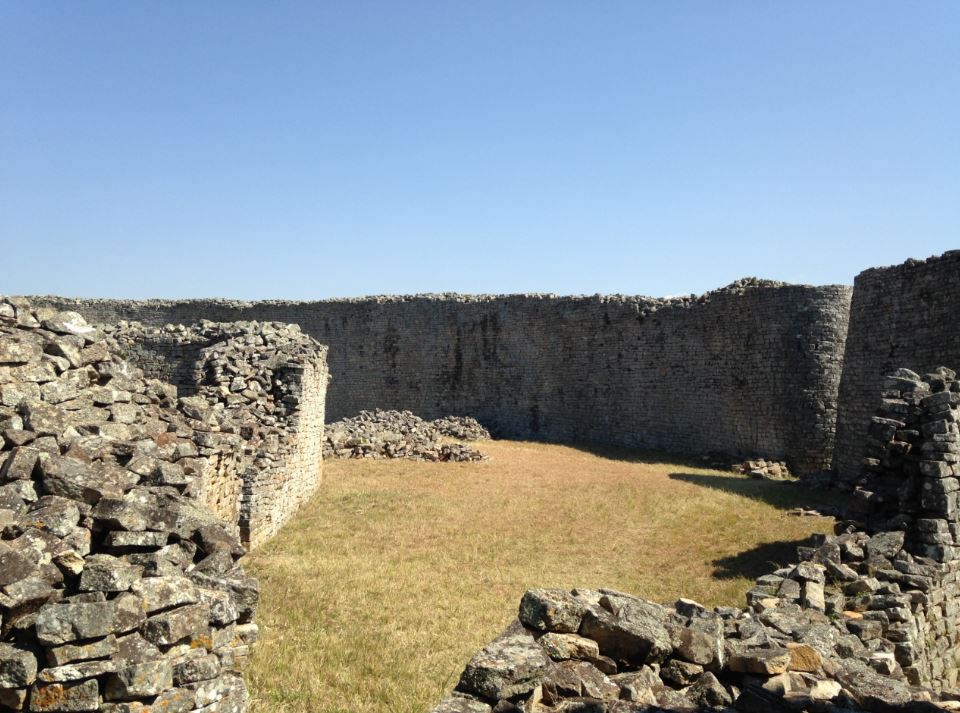Great Zimbabwe
Great Zimbabwe is an ancient ruin, dating back to around 800 years ago. It was an old fort and set of stone walls that were built to house the king of the region and his family, as well as his followers and the members of his village. It is also the site that gave its name to the country when it ceased to be called Rhodesia.
Claire and I had made our way to a lodge on the outskirts of the town of Masvingo, situated right near the ruins of Great Zimbabwe and had woken the next morning to head to the World Heritage Site. Our guide, Midzi, was fantastic with a real wealth of knowledge on the region, the ruins and Zimbabwe as a whole. We set off and made our way to the first set of walls. These were situated at the bottom of a giant hill, with the main fort being up at the summit. We wound our way through these walls, which were incredibly arranged. They were around 800 year old dry stone walls, meaning they weren’t held together with anything, and yet they were still standing. One line of kings had, according to Midzi, ruled the region for around four hundred years meaning they were the only family line to live in the fort. He said that the king would have had around 200 wives, with his senior wife living in another walled compound a few hundred metres away that we’d be getting to later on in the day. He would then have hundreds maybe thousands of children, with the son of the senior wife inheriting his throne once he dies.
After being filled in on a bit of information about the king, we then made our way up the mountain, weaving through the narrow stairs and corridors passing gigantic boulders. Once up to the top, inside the fort, the views were incredible. We could see for miles and it became clear why the king would choose to live in such a place. With the labyrinth of walls we’d had to navigate, it would’ve been very hard for an invader to get into the fort, especially with the guards dropping rocks down from above.
Once at the top we were presented with panoramic views of the surrounding areas. The labyrinth of walkways had led us up to a platform that was surrounded by walls, all cleverly crafted using pieces of rock. Midzi showed us where the king would have hung out with his family, as well as the places where the priests would have spent their time. Then we were shown a gigantic rock that was in the shape of an eagle. It was about the size of a house and to honour the eight kings who resided at Great Zimbabwe, eight miniature eagle models were carved out of the stone. A number were recovered in the fortress when archaeologists excavated the area, however, a number of others had been taken, including one that was placed in the Cecil Rhodes Museum in South Africa. However, all of them, bar one, are now back at the museum on site at Great Zimbabwe.
The next stop along the way was a cave that was situated at the top of the mountain within the fortress walls. The view from the cave was impressive. You could see for miles and miles, and according to Midzi, when the king wanted to summon his subjects to court he would order someone to blow a horn into the cave. The cave would then amplify the horn tenfold and the sound would bellow out over the kingdom. To show us the affect Midzi leant into the cave and shouted as loud as he could. The echoes of his voice rang out for miles and we could hear them bouncing back off the mountains in the distance.
This cave did, however, have another use. Before each new king was crowned a couple of rituals would have to take place. Firstly, he would have to head off into one of the surrounding rivers and kill a crocodile, before eating its tail. The people believed that the crocodile’s tail was where it held all of its power and in order to become a powerful man, the king would have to eat the tail. The next ritual would take place up in the cave. The king would have to take his favourite sister and have sex with her inside the cave away from view of the other members of the kingdom. Only a select few would know about this act and it would be done in order to prevent him from running amok. Incest was deemed an abomination at that time and if the king were to step out of line then his sister would be able to threaten him with revealing their dirty secret to his subjects. If this was revealed then the king would be seen as an abomination himself and would be unable to keep his throne. We were stunned.
After leaving the cave we then made our way back into the complex of the fort and Midzi turned our attention up to a gigantic rock. There was a tree stood on top of it and the root had split this gargantuan rock in half. According to Midzi, this root was seen as so powerful (due to the fact it could split a twenty metre high rock in two) that the men used to eat parts of the root as it was deemed a type of Viagra. The root was given the name ‘Muchemba mbuya’ which translates to ‘makes the woman cry’ – though Midzi assured us that it meant cries of joy.
We were also shown the Watergate. This gate lead from the top of the hill down to a valley where water would have been collected from. If a woman wanted to marry the king (and be one of his two hundred wives) then she would have to prove herself to him and his family. In order to do so she would take a clay calabash, which is like a round pot, and walk down from the top of the hill to the water. Then, once she had filled the calabash with water she would have to make the five hundred metre walk back up the mountain, carrying it on her head, to present the water to the king. If she dropped her calabash and it broke then she would be deemed unworthy and would go back to her family.
After making our way down the mountain we were taken to a gigantic walled structure that was at one point eleven metres high. It was in a giant circle and the space inside was about the size of a football pitch. Inside was where the number one wife would live with her family and servants. It was her firstborn who was next in line for the throne, so she needed a fine place to live. This structure was magnificent. It was hundreds of years old, no adhesive was used, meaning it was a dry stone wall, and it was still standing. Also, the design was beautiful to look at, with lines and lines of evenly spaced and equally sized pieces of stone used.
Claire spotted her favourite tree, the giant cactus, inside the ruins and asked Midzi what his favourite was. Apparently his name translates to ‘roots’ and so his favourite tree is the mango tree, because it’s roots go deep and hold it firmly in place.
Midzi was a fantastic guide and knew so much about Great Zimbabwe. We spoke to him about his training and it turned out that he spent four years at university studying history. His course spent some time on Zimbabwean history but also covered global history including other parts of Africa, South America and Europe. Then, once he applied for a job as a guide at Great Zimbabwe, he had to spend an entire month learning the history of the monument and the local area. He was absolutely fantastic and always had an answer to our questions. We were talking about how the information was passed down and how people would have, back in the day, often sat around after dinner and listened to the elders tell tales from the past. “Your grandfather would say ‘in the past this, this, this and this happened’, but now Playstations are around and people just want to play Fifa 16”. I told him that whilst I agreed with the sentiment of what he was saying, Fifa 16 is a very good game.








Comments are closed here.